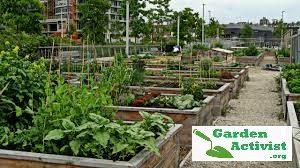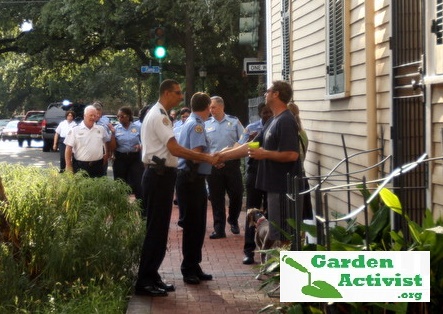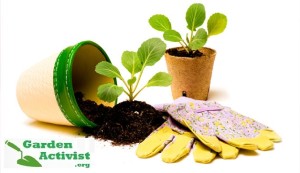
Community gardening improves people’s quality of life by providing a catalyst for neighborhood and community development, stimulating social interaction, encouraging self-reliance, beautifying neighborhoods, producing nutritious food, reducing family food budgets, conserving resources and creating opportunities for recreation, exercise, therapy and education.
 Empowers Community
Empowers Community
• Community gardens increase a sense of community ownership and stewardship.
• Community gardens foster community identity and spirit.
• Community gardens bring people together (age, race, culture, social class).
• Community gardens build community leaders.
• Community gardens offer a focal point for community organizing, and can lead to community-based efforts to deal with other social concerns.

New Orleans Police Department working with community gardeners
Crime Prevention
• Community gardens build block clubs (neighborhood associations).
• Community gardens increase eyes on the street.
• Community gardening is recognized by the many police departments as an effective community crime prevention strategy.
Cultural Opportunities
• Community gardens offer unique opportunities for new immigrants (who tend to be concentrated in low-income urban communities) to:
– Produce traditional crops otherwise unavailable locally,
– Take advantage of the experience of elders to produce a significant amount of food for the household,
– Provide inter-generational exposure to cultural traditions,
– Offer a cultural exchange with other gardeners,
– Learn about block clubs, neighborhood groups, and other community information.
• Community gardens offer neighborhoods an access point to non-English speaking communities.
• Community gardens allow people from diverse backgrounds to work side-by-side on common goals without speaking the same language.
Youth
 Community gardens offer unique opportunities to teach youth about:
Community gardens offer unique opportunities to teach youth about:
• Where food comes from
• Practical math skills
• Basic business principles
• The importance of community and stewardship
• Issues of environmental sustainability
• Job and life skills
• Community gardening is a healthy, inexpensive activity for youth that can bring them closer to nature, and allow them to interact with each other in a socially meaningful and physically productive way.
 Food Production
Food Production
• Many community gardeners, especially those from immigrant communities, take advantage of food production in community gardens to provide a significant source of food and/or income.
• Community gardens allow families and individuals without land of their own the opportunity to produce food.
• Community gardens provide access to nutritionally rich foods that may otherwise be unavailable to low-income families and individuals.
• Urban agriculture is 3-5 times more productive per acre than traditional large-scale farming!
• Community gardens donate thousands of pounds of fresh produce to food pantries and involve people in processes that provide food security and alleviate hunger.
 Health
Health
• Studies have shown that community gardeners and their children eat healthier diets than do non-gardening families.
• Eating locally produced food reduces asthma rates, because children are able to consume manageable amounts of local pollen and develop immunities.
• Exposure to green space reduces stress and increases a sense of wellness and belonging.
• Increasing the consumption of fresh local produce is one of the best ways to address childhood lead poisoning.
• The benefits of Horticulture Therapy can be and are used to great advantage in community gardens.
Green Space
• Community gardens add beauty to the community and heighten people’s appreciation for living things.
• Community gardens filter rainwater, helping to keep lakes, rivers, and groundwater clean.
• Community gardens restore oxygen to the air and help to reduce air pollution.
• Community gardens recycle huge volumes of tree trimmings, leaves, grass clippings, and other organic wastes back into the soil.
• Community gardens provide a place to retreat from the noise and commotion of urban environments.
• Community gardens provide much needed green space in lower-income neighborhoods which typically have access to less green space than do other parts of the community.
• Development and maintenance of garden space is less expensive than that of parkland.
• Scientific studies show that crime decreases in neighborhoods as the amount of green space increases.
• Community gardens have been shown to actually

